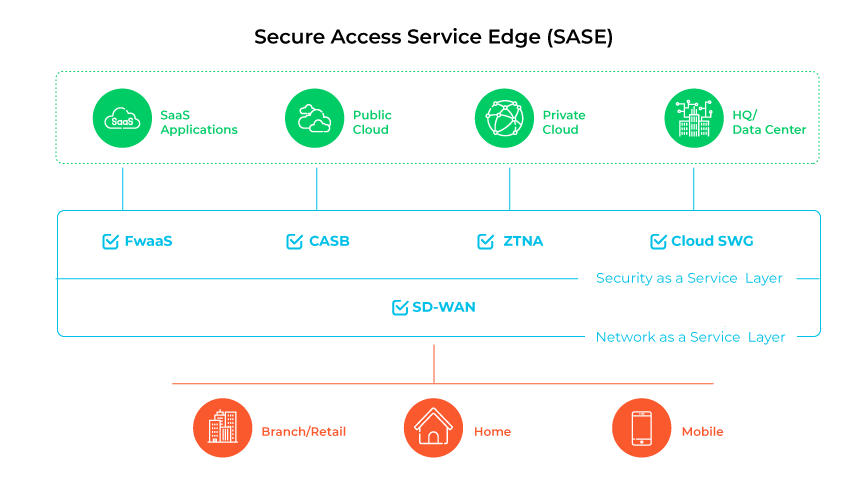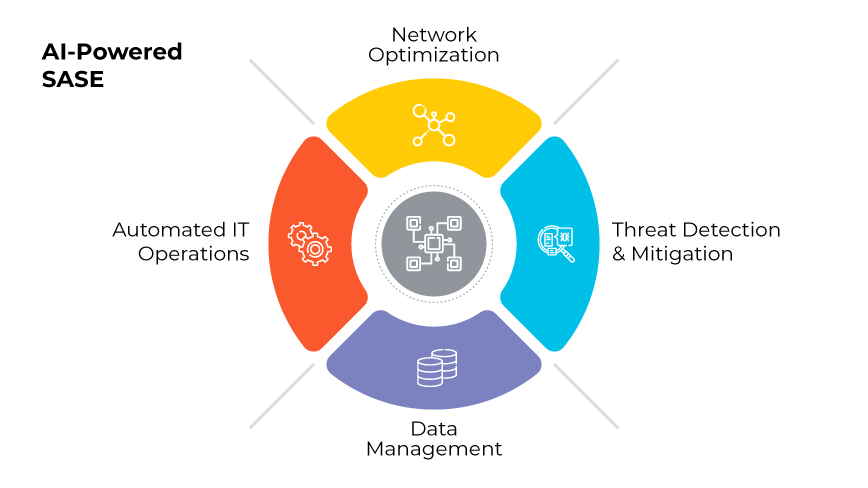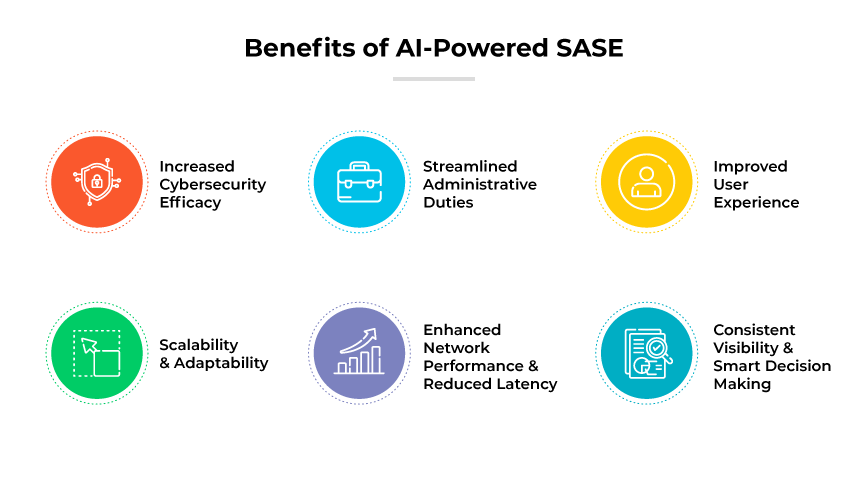What Is AI-Powered SASE?
AI-Powered SASE is a cloud-based network architecture that integrates AI-enhanced SWG, SD-WAN, CASB, and ZTNA for efficient security and networking.
By using AI, this model provides autonomous management and predictive analytics, enhancing operational efficiencies. AI-Powered SASE helps identify and mitigate potential issues proactively, ensuring a robust, efficient network environment.
What Is Secure Access Service Edge (SASE)?

SASE (secure access service edge) is a cloud-based security framework that provides secure access to network resources from anywhere.
Traditional network approaches and technologies simply no longer provide the security and access control digital organizations need. Modern enterprises require immediate, uninterrupted access for users, regardless of location. The rise in remote users, use of cloud-based applications, and increased data flow toward cloud services and branch offices, rather than back to data centers, necessitates a new network security approach.
Adopting SASE solutions delivers multiple business benefits:
- Flexibility
- Cost savings
- Reduced complexity
- Increased performance
- Zero Trust
- Threat prevention
- Data protection
The Role of AI in SASE
Artificial intelligence (AI) now plays a pivotal role in secure access service edge (SASE) architecture. This transformative technology has introduced capabilities that enable efficient security measures and enhanced networking outcomes.
User Experience
AI significantly bolsters SASE user experience. SASE architecture leverages globally distributed cloud services to provide superior security and improve user experience. AI technologies allow for effective autonomous digital experience management (ADEM), measuring the health and performance of connectivity from user devices to application destinations.
AI plays a crucial role in data aggregation across the network, enabling IT administrators to correlate signals from network monitoring or user-reported issues. AI can consolidate multiple inputs into a single issue, thus aiding administrators in identifying and resolving problems efficiently. AI’s preemptive capabilities can help flag potential issues before users report them, facilitating a more proactive network management approach.
Cybersecurity
AI is not a novel concept in cybersecurity management. Techniques derived from machine learning (ML) and AI have long been implemented to identify security threats. One such application is the detection of phishing kits. Utilizing AI and ML methodologies, SASE can identify when phishing kits generate such pages, thus preventing users from accessing malicious websites and enhancing the overall network security posture. Advanced URL filtering can also help prevent SaaS platform phishing attacks.
Data
AI's effectiveness is primarily reliant on the quality and quantity of data at its disposal. In the context of SASE, AI can leverage data collected from security, networking, and operations, which is then gathered in one central place.
It is important to note that the principles of complete, consistent, and correct data underpin AI's efficiency. Complete data implies collecting all data related to the problem at hand, while consistent data refers to the unchanging formatting, structure, and labeling across all data elements. Correct data suggests that the data collection process is reliable, ensuring trustworthy data output.
AI technology in SASE, by adhering to these principles, can drive transformational outcomes across various core areas such as security, networking, and operations.
AI Operations (AIOps)
AI Operations (AIOps) integration within SASE has further expanded the scope of AI in automating complex IT operations. AIOps facilitates AI-based problem detection and predictive analytics to proactively remediate issues that might cause service interruption.
AIOps adoption in SASE increases productivity and reduces mean time to resolution (MTTR) by providing simplified, rapid discovery of network anomalies from a single dashboard.
How Does AI-Powered SASE Work?

AI-powered secure access service edge (SASE) leverages artificial intelligence and machine learning to enhance the security and performance of cloud-based networking. To understand how it functions, it's crucial to focus on its two main pillars: networking and security, both of which benefit from the application of AI technologies.
AI-powered SASE optimizes network performance by applying AI to manage network traffic more efficiently. For instance, AI can predict network demands based on historical data and user behavior, which enables it to allocate network resources proactively, reducing latency and enhancing the overall user experience.
In terms of security, AI plays a pivotal role in identifying and mitigating potential threats. Machine learning continuously analyzes network behavior and detects anomalies, which could indicate a potential cyberthreat. When a possible threat is detected, the system can isolate it and prevent it from spreading through the network, thereby mitigating the risk. Furthermore, the system learns from every interaction, which enables it to identify new threat patterns over time and continuously enhances its ability to protect the network.
Another vital aspect of AI-powered SASE is its data management capability. As it operates, it collects a vast amount of data from network and security events. This data is stored in a central data lake, which not only facilitates a unified view of the system but also provides the raw material for the AI algorithms to learn and improve. AI use ensures effective data management and derives meaningful insights for decision-making.
The role of AI in automating complex IT operations cannot be overstated. It helps automate various operational functions such as issue detection, predictive analysis, and problem resolution, thereby reducing the time to resolve issues and increasing productivity.
Ultimately, AI-powered SASE enhances network performance and security by applying AI technologies to predict network demands, detect threats, manage data, and automate operations. Its capability to learn from data enables it to continuously adapt and improve, making it an essential tool for organizations to secure their networks in a cloud-first world.
Benefits of AI-Powered SASE

Increased Cybersecurity Efficacy
AI-Powered SASE provides enhanced security through machine learning techniques. This allows the system to cover a wider spectrum of threats compared to traditional security measures. Specifically, AI can enhance detection of DNS-based threats and unknown, evasive threats, thereby improving overall security efficacy.
In addition, AI-Powered SASE solutions can often be tailored to meet industry-specific security and compliance requirements.
AI also plays a crucial role in enhancing real-time threat detection and prevention within the SASE framework. In fact, it offers real-time prevention of unknown and highly evasive threats by continuously analyzing network behavior.
Machine learning algorithms can analyze webpage source code, images, text, and URL patterns to detect potential threats and mitigate them effectively, offering an added layer of threat intelligence. This level of analysis increases phishing detection and prevention capabilities, and also covers similar cybersecurity threats.
AI's role in cybersecurity extends beyond detection and includes proactive threat mitigation. Through continuous learning and pattern recognition, AI can predict potential threats and take preventive measures, thereby strengthening the overall cybersecurity posture within the SASE framework.
Streamlined Administrative Duties
AI-Powered SASE provides benefits to both end-users and IT administrators. Administrators can leverage AI to reduce administrative burden and simplify management, allowing them to focus on high-value tasks instead of troubleshooting or managing multiple consoles. By automating many of the manual tasks associated with IT administration, AI-powered SASE can significantly enhance operational efficiency.
Additionally, AI-powered SASE integrates AIOps to automate complex IT and NOC functions, thereby increasing productivity and reducing mean time to resolution. This allows IT professionals to proactively remediate issues that can cause service interruption through AI-based problem detection and predictive analytics.
Improved User Experience
AI not only provides benefits to IT professionals but also significantly improves the end-user experience. By enabling real-time visibility and problem-solving capabilities, AI helps in providing seamless user experiences and helps IT professionals quickly address any potential issues.
Scalability and Adaptability
AI-powered SASE is highly adaptable and scalable, allowing it to accommodate changing business needs efficiently. Unlike traditional hardware-based architectures that can be challenging to scale, AI-powered SASE can easily adapt to changes such as business growth, acquisitions, or the addition of new office locations.
Enhanced Network Performance and Reduced Latency
Although AI may not directly influence network performance and latency reduction, it can contribute to these aspects by facilitating more efficient routing and the timely detection and mitigation of network issues.
Plus, AI-powered SASE systems facilitate secure and efficient access to applications and resources for remote users. While AI isn’t directly involved in connection routing, automation and learning capabilities can optimize the network for better performance and security.
Consistent Visibility and Smart Decision-Making
The convergence of SD-WAN with a cloud-delivered security service edge (SSE) in an AI-powered SASE framework helps organizations maintain consistent visibility across their network. By leveraging AI and machine learning, smarter and data-driven decisions can be made for improved network management and security.
The Future of AI-Powered SASE
AI holds great promise for the future of secure access service edge (SASE) technology. With its capability to automate, analyze, and optimize, AI has the potential to revolutionize various aspects of network security, performance, and operations.
A primary area of focus in the ongoing development of AI-powered SASE is the integration of natural language interfaces. These interfaces simplify the complex tasks often encountered by IT administrators by providing a mechanism to interact with the system using plain English queries. This advancement could expedite troubleshooting and problem resolution, reducing what could typically be an hour-long investigation into an instantaneous response.
For instance, an IT administrator could utilize a natural language interface to quickly diagnose whether a specific user can access a particular application. The AI system, with its ability to analyze various factors like security policies, network health, and application status, can provide an intelligent, concise response. This mitigates the need to navigate multiple dashboards and drastically reduces the time taken to diagnose and resolve issues.
AI's potential influence extends beyond problem-solving and into the realm of prediction. AI-powered SASE can learn from patterns and behaviors to foresee potential network or security issues, providing proactive solutions before problems arise. This predictive capacity amplifies the efficacy of SASE, contributing to a more secure, efficient, and robust network environment.
Moreover, AI-powered SASE consolidates what were once disparate technologies into a unified solution, enhancing user-centricity. It facilitates the simultaneous analysis of a range of network and security parameters, ultimately delivering an integrated, efficient, and effective solution. As the SASE landscape evolves, this level of integration will become increasingly critical, further emphasizing the necessity of AI.
The future of AI-powered SASE is a transformative one. The incorporation of AI allows SASE to evolve beyond a secure networking framework into a highly intelligent, proactive, and user-centric solution. As AI technology continues to advance and mature, its integration with SASE will become even more profound, significantly impacting security, network management, and operations in the near future.
AI-powered SASE FAQs
Standard SASE, or non-AI-powered SASE, typically includes the following features:
- Software-defined wide area networking (SD-WAN): This offers network connectivity across multiple locations while enabling direct access to cloud services.
- Security features: These include secure web gateways, firewall as a service, data loss prevention, and other threat prevention capabilities.
- Zero Trust network access (ZTNA): This limits access to the network on a need-to-know basis, thereby improving security.
- Enhanced network performance: AI can predict network demands based on historical data and user behavior, allocating network resources proactively. This can reduce latency and improve overall user experience.
- Improved security: AI plays a crucial role in identifying and mitigating potential threats. Machine learning analyzes network behavior and detects anomalies, indicating potential cyberthreats. The system can then isolate these threats and prevent them from spreading throughout the network.
- Data management: AI-powered SASE collects data from network and security events, storing it in a central data lake. This data helps AI algorithms to learn and improve, providing meaningful insights for decision-making.
- Automated operations: AI helps automate various operational functions such as issue detection, predictive analysis, and problem resolution, reducing time to resolve issues and increasing productivity.
While AI-powered SASE does provide enhanced security, it's important to note that no solution can guarantee 100% security. Organizations must also implement best security practices, such as employee training, strong password policies, and regular system updates, to supplement the security provided by AI-powered SASE.
- Improved network performance
- Predictive analysis
- Automated issue resolution
- Adaptive security measures